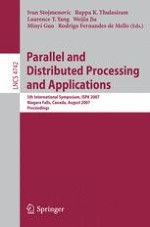2007 | Buch
Parallel and Distributed Processing and Applications
5th International Symposium, ISPA 2007 Niagara Falls, Canada, August 29-31, 2007 Proceedings
herausgegeben von: Ivan Stojmenovic, Ruppa K. Thulasiram, Laurence T. Yang, Weijia Jia, Minyi Guo, Rodrigo Fernandes de Mello
Verlag: Springer Berlin Heidelberg
Buchreihe : Lecture Notes in Computer Science
